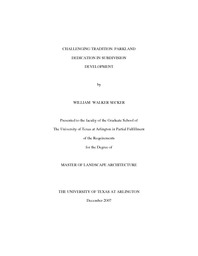
ATTENTION: The works hosted here are being migrated to a new repository that will consolidate resources, improve discoverability, and better show UTA's research impact on the global community. We will update authors as the migration progresses. Please see MavMatrix for more information.
Show simple item record
| dc.contributor.author | Secker, William Walker | en_US |
| dc.date.accessioned | 2008-04-22T02:41:19Z | |
| dc.date.available | 2008-04-22T02:41:19Z | |
| dc.date.issued | 2008-04-22T02:41:19Z | |
| dc.date.submitted | December 2007 | en_US |
| dc.identifier.other | DISS-1893 | en_US |
| dc.identifier.uri | http://hdl.handle.net/10106/710 | |
| dc.description.abstract | Growth patterns of the last half century have been urbanizing the American landscape (Corrigan, et al, 2004). This new landscape has been created by the horizontal development of single-use, single-family residential housing subdivisions (Berger, 2006). The physical design of these subdivisions is the direct result of rational zoning, subdivision laws, and ordinances that were adapted for the automobile as well as market demands (Steiner, 1994). These land development strategies have created a multitude of housing opportunities for the American public, but also have created growth patterns that separate people from the natural environment and related activities (Duany, Plater-Zyberk, and Speck, 2000).
This thesis identifies an economically defendable and consumer-oriented strategy that potentially re-incorporates the natural environment and its associated activities and benefits through parkland dedication within residential subdivision developments. This research is not intended to cure the ills espoused by anti-sprawl activists and does not address the controversial and much larger issues of traditional development practices associated with sprawl. Rather, it accepts the market demands for suburban housing stock and provides an alternative to traditional development. This research addresses alternate development strategies and the market base for their support by residential housing consumers.
Primary research methods include quantitative data collection and analysis for two existing residential areas in Tyler, Texas. County appraisal figures compose these data, which in turn are evaluated by the researcher to validate the positive economic impacts of parkland on residential property values. Second, the residents of a traditional subdivision development in Tyler, Texas, were surveyed to determine the market demand and economic potential for parkland dedication within this subdivision.
This study offers a basis for alternative planning and design strategies. These strategies can assist in the decision making process of policy makers, land developers, and designers aspiring to provide the public with rich and diverse community options. | en_US |
| dc.description.sponsorship | Taylor, Pat D. | en_US |
| dc.language.iso | EN | en_US |
| dc.publisher | Landscape Architecture | en_US |
| dc.title | Challenging Tradition: Parkland Dedication In Subdivision Development | en_US |
| dc.type | M.L.A. | en_US |
| dc.contributor.committeeChair | Taylor, Pat D. | en_US |
| dc.degree.department | Landscape Architecture | en_US |
| dc.degree.discipline | Landscape Architecture | en_US |
| dc.degree.grantor | University of Texas at Arlington | en_US |
| dc.degree.level | masters | en_US |
| dc.degree.name | M.L.A. | en_US |
| dc.identifier.externalLink | https://www.uta.edu/ra/real/editprofile.php?onlyview=1&pid=1152 | |
| dc.identifier.externalLinkDescription | Link to Research Profiles | |
Files in this item
- Name:
- umi-uta-1893.pdf
- Size:
- 8.801Mb
- Format:
- PDF
This item appears in the following Collection(s)
Show simple item record


